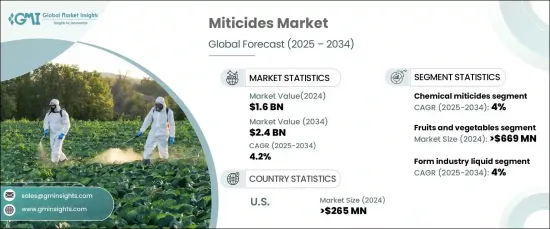
살비제 세계 시장은 2024년에는 16억 달러로 평가되었고, 2025년부터 2034년에 걸쳐 CAGR 4.2%를 나타낼 전망입니다.
시장 수요의 급증은 주로 세계의 식량 수요 증가와 농업 생산성을 극대화할 필요성에 의해 야기됩니다. 세계 인구가 증가함에 따라 농부들은 작물을 보호하고 높은 수율과 우수한 품질을 보장하기 위해 화학 살비제와 생물학적 살비제 모두를 사용합니다. 게다가, 생물학적 방제와 화학적 방제를 결합하는 종합적 해충 관리(IPM) 전략에 대한 인식도 향상되어 더 나은 결과를 얻고 있습니다. 이러한 실천이 시장 확대를 가속화하고 있습니다.

살비제 시장은 현대농업이 작물보호와 수율 최적화를 도입함에 따라 변혁적인 변화를 경험하고 있습니다. 제제기술과 살포기술의 진보에 더해 생물학적 솔루션의 채용이 증가하고 있는 것이 시장의 양상을 바꾸고 있습니다. 동시에 효과적인 해충 관리 프로그램에 대한 규제 당국의 지원과 지속 가능한 농법에 대한 지식의 확대가 업계에 새로운 성장 기회를 가져오고 있습니다. 따라서 효율적이고 환경 친화적인 해충 제거 솔루션에 대한 수요가 전례 없이 높아지고 있으며, 장기적인 시장 개척을 위한 역동적인 시장 환경이 형성되고 있습니다.
| 시장 범위 | |
|---|---|
| 시작 연도 | 2024 |
| 예측연도 | 2025-2034 |
| 시작 금액 | 16억 달러 |
| 예측 금액 | 24억 달러 |
| CAGR | 4.2% |
작물 유형별로는 과일 및 야채 분야가 시장을 독점해, 2024년에는 6억 6,900만 달러로 평가되었습니다. 이 분야는 이러한 작물의 진드기 피해에 대한 취약성이 높기 때문에 예측기간 동안 CAGR 3.9%를 나타낼 전망입니다. 진드기의 피해는 농산물의 외관, 영양가, 전반적인 시장성에 심각한 영향을 미칠 수 있으며, 품질을 유지하기 위해서는 효과적인 해충 방제가 필수적입니다. 고부가가치 작물에 대한 수요 증가와 수확 후 손실을 최소화하는 것에 대한 관심이 높아짐에 따라 이 범주에서 살비제 수요가 더욱 높아지고 있습니다.
화학 살비제 시장을 선도하고 있으며, 2024년에는 13억 달러의 수익을 올렸으며, 2034년까지의 CAGR 성장률 4%로 예측되고 있습니다. 이 인기는 즉효성, 폭넓은 효능, 진드기 개체수의 관리에 있어서 입증된 신뢰성에 의해 초래되고 있습니다. 유기 인산염, 피레스로이드, 카르바마트 등의 합성 화합물은 보호 효과가 장기간 지속되고 농업용도에 범용성이 있기 때문에 일반적으로 사용되고 있습니다. 화학 살비제의 우위성은 계속되고 있지만, 지속 가능한 농법이 중시되게 됨으로써, 친환경적인 해결책을 요구하는 소비자나 규제 당국의 요구가 높아지고, 생물학적 대체제로의 이행이 서서히 진행되고 있습니다.
미국의 살비제 시장은 2024년에 2억 6,500만 달러로 평가되었고, 2034년까지 연평균 복합 성장률(CAGR) 4.5%로 성장할 것으로 예측됩니다. 이 나라의 광범위한 농업 부문은 강력한 해충 관리 실천과 함께 시장의 지속적인 성장의 기반이되었습니다. 미국에서는 과일, 야채, 곡물의 생산량이 많기 때문에 진드기의 침입으로 인한 손실을 방지하기 위해 효과적인 해충 방제가 필요합니다. 또한 주요 농업 관련 기업의 존재, 첨단 R&D 이니셔티브, 견고한 유통망을 통해 미국은 세계 살비제 시장에서 주요 기업로서의 지위를 강화하고 있습니다.
The Global Miticides Market is set to reach USD 1.6 billion in 2024 and is projected to experience steady growth with a CAGR of 4.2% between 2025 and 2034. The surge in market demand is primarily driven by the rising global food demand and the need to maximize agricultural productivity. As the world population grows, farmers are increasingly turning to both chemical and biological miticides to protect their crops and ensure high yields and superior quality. Additionally, there is growing awareness about integrated pest management (IPM) strategies, which combine biological and chemical controls for better results. These practices are accelerating the market's expansion.

The miticides market is experiencing a transformative shift as modern agriculture embraces crop protection and yield optimization. Advancements in formulation technologies and application techniques, coupled with the increasing adoption of biological solutions, are reshaping the landscape. At the same time, regulatory support for effective pest management programs and the expanding knowledge of sustainable farming practices are opening up new growth opportunities for the industry. This creates a dynamic market environment poised for long-term development, where the demand for efficient, eco-friendly pest control solutions is stronger than ever before.
| Market Scope | |
|---|---|
| Start Year | 2024 |
| Forecast Year | 2025-2034 |
| Start Value | $1.6 Billion |
| Forecast Value | $2.4 Billion |
| CAGR | 4.2% |
In terms of crop type, the fruits and vegetables segment dominated the market, contributing USD 669 million in 2024. This segment is expected to grow at a CAGR of 3.9% over the forecast period, driven by the high vulnerability of these crops to mite infestations. Mite damage can severely impact the appearance, nutritional value, and overall marketability of produce, making effective pest control crucial for maintaining quality. The increasing demand for high-value crops, along with the growing concern over minimizing post-harvest losses, further enhances the demand for miticides within this category.
Chemical miticides are leading the market, generating USD 1.3 billion in revenue in 2024, with a forecasted growth rate of 4% CAGR through 2034. Their popularity is driven by their fast-acting nature, broad-spectrum efficacy, and proven reliability in managing mite populations. Synthetic compounds such as organophosphates, pyrethroids, and carbamates are commonly used due to their long-lasting protection and versatility in agricultural applications. Despite the continued dominance of chemical miticides, the increasing emphasis on sustainable farming practices is fostering a gradual shift toward biological alternatives, which are gaining traction in response to growing consumer and regulatory demand for environmentally friendly solutions.
The U.S. miticides market, valued at USD 265 million in 2024, is expected to grow at a 4.5% CAGR through 2034. The country's extensive agricultural sector, combined with strong pest management practices, serves as a foundation for continued growth in the market. The high production of fruits, vegetables, and grains in the U.S. necessitates effective pest control to prevent losses caused by mite infestations. Moreover, the presence of leading agricultural firms, advanced research and development initiatives, and robust distribution networks strengthen the U.S. position as a key player in the global miticides market.